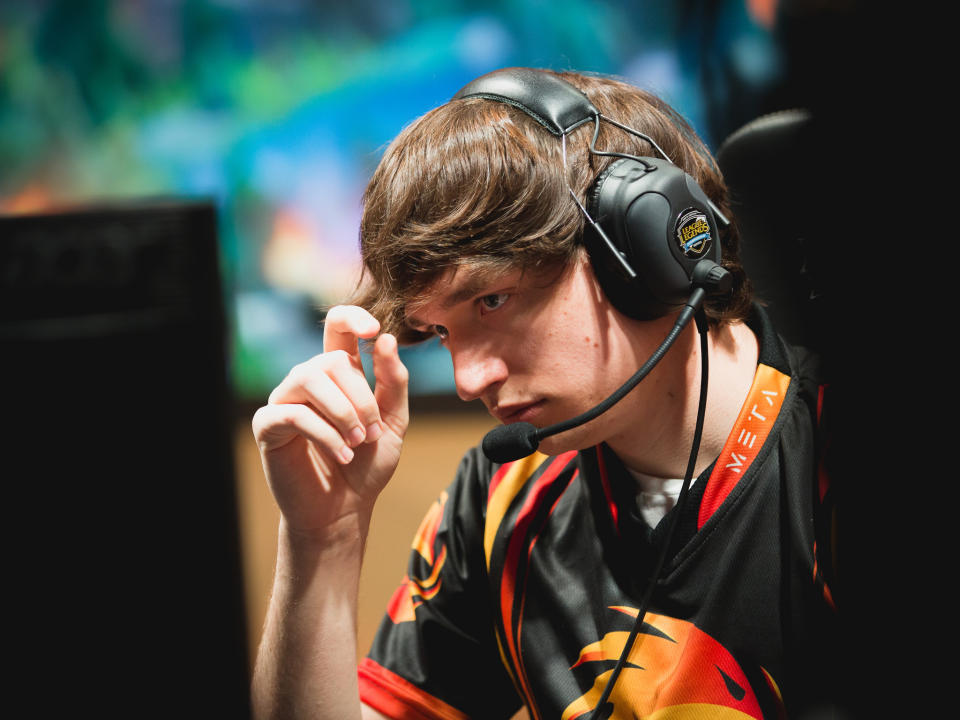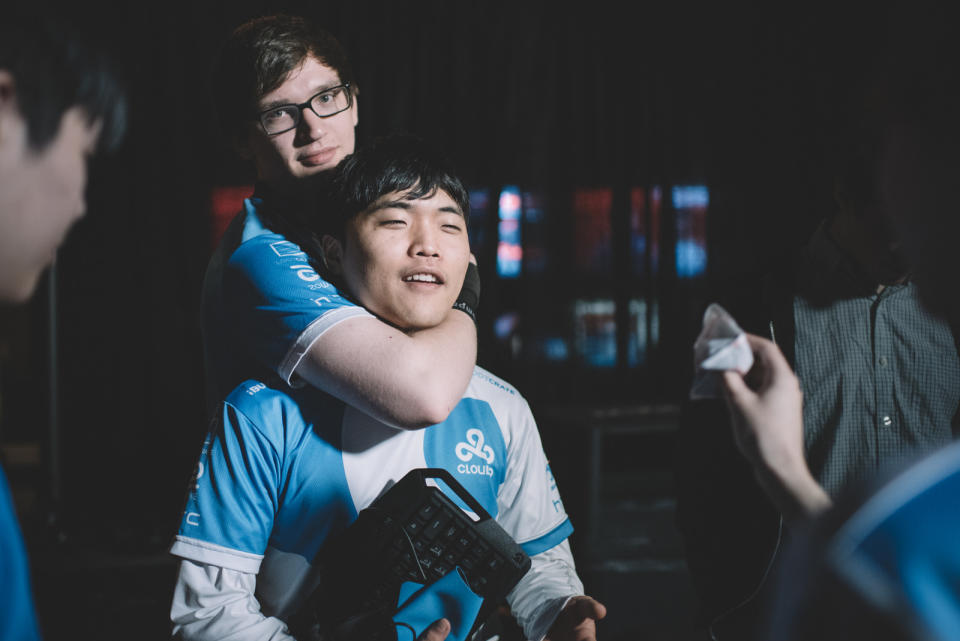Meteos or Inori: A look at Phoenix1's jungle dilemma

When Phoenix1 swept Cloud9 in Week 5 of the 2017 North American League of Legends Championship Series Spring, it was an upset.
In previous weeks, Phoenix1 had given FlyQuest a good fight and went toe-to-toe with Team SoloMid in a close 2-1 series. Unfortunately, both resulted in losses. They had also dropped a series to an inconsistent Counter Logic Gaming squad, and NA’s top teams had appeared to be out of their reach. Beating Cloud9, the first-place team in NA at the time, was unexpected.
More surprising than the win; however, was the young man in P1’s jungle: former C9 mainstay, William “Meteos” Hartman.
“I’ve got nothing to lose. Everyone knows I haven’t really been playing that much League, I was kind of brought in last second,” he told David “Phreak” Turley after the victory. “For me, it was just a fun match against my friends. Just see how they’re doing, see how I’m doing — it’s kind of a low-pressure situation for me.”
Parity in the NA LCS was discussed well before the season began. Phoenix1 is just one of many new hybrid rosters to grace the North American League of Legends scene this spring in a list that includes Team Liquid, Immortals, Team Dignitas, Echo Fox, and Team EnVyUs. Predicting how a lineup will come together if all members speak the same language and come from the same country is difficult. Predicting how a lineup will come together with various imports is near-impossible. Phoenix1 were placed in a nebulous “wait and see” category by most commentators and analysts.
Upon seeing, Phoenix1 made for an interesting specimen. Aggressive jungler Rami “Inori” Charagh had already impressed on P1 last year in their surprise upset over TSM. Now paired with the steady veteran Yoo “Ryu” Sang-ook, Inori was poised for a breakout season. While Phoenix1 rose above other hybrid rosters, they were unable to contend with the top of the league which continued to be dominated by TSM and C9, along with the familiar faces of FlyQuest.
Then Meteos stepped in.
When Meteos returned to the NA LCS on Phoenix1, it was somewhat of an emergency situation. There was no melodramatic ripping out of an intravenous cord with the cry of, “My team needs me!” in the vein of Heo “PawN” Won-seok’s famous substitution according to EDward Gaming’s San Shao in the 2015 LPL playoffs, but with Inori headed home to attend to a personal matter, Phoenix1 chose Meteos as their substitute.

Meteos was admittedly rusty. The same offseason that saw most organizations craft hybrid rosters for also saw Meteos replaced by rookie Juan “Contractz” Arturo Garcia, a top performer for C9’s former Challenger team. The 2016 League of Legends World Championship was not a strong showing from Meteos. Introspective and occasionally self-effacing, Meteos gamely tried to stave this off, but mounting community criticism took its toll.
Three weeks before C9 Challenger became FlyQuest, Cloud9 picked up Contractz as their full-time LCS jungler for the 2017 spring season. It was a smart decision, one that rewarded the team with an undefeated series record through Week 4 and a 16-4 overall game record. Contractz, despite his fair share of rookie mistakes, has proved to be a bright talent and eager student — the new face of the NA jungle alongside fellow rookie Matthew “Akaadian” Higginbotham. With Galen “Moon” Holgate performing well for FlyQuest, the community clamor for Meteos to return to his former C9 teammates died down. By the time his Phoenix1 debut was announced, he was out of practice.
“I’ve kind of been taking a break from League,” he said on broadcast after his first series with P1. “For six years I’ve played it for 12 hours a day or more. The past few months, I’ve just kind of been chilling. I think my mechanics are pretty bad.” He shook his head while conceding that he did “a moderate bit of feeding.”
Meteos returned to the LCS stage with darker hair and a sheepish smile. His first series was against Nam “LirA” Tae-yoo and the floundering Team EnVyUs. It was a slow start, with LirA ahead of him early, harassing his clear and generally staying ahead in the vision game. Meteos’ pathing was straightforward while he reacquainted himself with competitive play. nV continued to garner leads, growing their advantages until 55:31, when Meteos out-Smited LirA for a crucial Baron steal. P1’s star AD carry Noh “Arrow” Dong-hyeon cleaned up the ensuing teamfight. One minute and 10 seconds later, Phoenix1 won the game. When P1 killed off nV’s Nexus, they were still 2K behind nV in cumulative gold.
LirA bested Meteos again early in Game 2, chasing Meteos out of his own jungle after an invade, which eventually resulted in another death for the returning jungler. Meteos was clear about what he wanted to do, but his execution and communication was visibly clunky. This time, P1 capitalized on a disjointed nV skirmish near the mid lane that began with an attempted pick onto Meteos himself.
With each passing game, Meteos reacquainted himself with the competitive jungle position and his new role on Phoenix1. His routes were workmanlike — a direct result of his wealth of experience. With Meteos in the jungle, Phoenix1 have a 10-3 overall game record — including their last series where he split time with Inori — and only one series loss. In Week 7, P1 kept Meteos in the jungle despite Inori’s return to the team. Following their second match that week, a 2-0 over Echo Fox, a subdued Inori joined Julian “Pastrytime” Carr onstage following his first game back.
“It was pretty hard,” Inori said. “Meteos has been playing really well. I’m happy the team’s doing well but I’m just kind of upset that I don’t get the chance to play as much. I understand the situation, he’s a really good jungler and I’m trying to learn as much as I can from him and hopefully I can improve.”

Rami “Inori” Charagh from Phoenix1 (Riot Games/lolesports)
There’s an apt comparison between Meteos and former SK Telecom T1 jungler Bae “bengi” Seong-woong, not only in the memetic lexicon of the community — “Dark Meteos” and the “Dark Flame Master” respectively — but in the roles they have played on their former, and in the case of Meteos, current teams. Whenever another jungler took to the Rift under SKT, fans cried out for bengi — most famously, last year at the 2016 World Championship. Known for his patience and diligence, bengi provided a comfortable routine with which SKT — especially Lee “Faker” Sang-hyeok — were already familiar. Bengi had visible weakness and visible strengths but his most valuable asset was the intelligent way that he applied his vast experience to his jungle paths and patterns.
A cursory glance at Inori’s pathing while on Phoenix1 reveals a lack of understanding and experience — two hallmarks of Meteos. Even in Inori’s stronger carry performances this year, he gives up early resources to opponents and sometimes forces invades or ganks without proper backup and vision. He’s more willing to help his lanes early, and knows how to effectively grow his advantages, but is often stymied when set behind.
Meteos’ first few games showcased a myriad of early struggles but his in-game experience was also present — intelligently avoiding wards, opting out of risky plays while still growing accustomed to his new teammates, and instinctive movement in teamfights. These are all specific, minute details that translate into one key factor: patience. If Meteos falls behind early, he is patient and usually knows how to help his team. When faced with challenging circumstances in game, Meteos can draw upon a library of experience to find a solution.
This puts P1 in a difficult situation. Similarly, Bengi’s SKT spent the majority of last year fluctuating between bengi and Kang “Blank” Sun-gu. Whenever Blank struggled, he bore the brunt of criticism against SKT as a whole. Brought on during a time when bengi struggled to adapt to more of a DPS jungler meta, Blank did not blossom into a hard carry jungler until a year later, and was never the second coming of bengi. SKT stuck with Blank until they required bengi’s style and experience.
When comparing the two, Inori has a higher damage per minute average (409) and a higher kill participation percentage (71.1 percent, first of all NA junglers) but even those numbers are negligible. They point more towards Inori’s carry style than anything else. By contrast, Meteos has the second-highest experience difference at 10 minutes (159) and third-highest CS difference at 10 minutes (3.8), and this nods to his farming efficiency. Many of their statistics are comparably inconsequential.
They receive a similar percentage of gold from their team — Inori edging out Meteos 20.3 percent to 19.6 percent — and deal an almost identical percentage of their team damage. Interestingly enough, Inori receives the fourth-highest percentage of his team’s CS after 15 minutes (17.2 percent) while Meteos receives the least of all NA junglers (14.3 percent). This is another nod to the productivity of Meteos. Due to his experience, he knows how to do more with less. Inori is more willing to affect his lanes early but makes riskier decisions.
P1 has said repeatedly that they highly value Inori. Just last week, P1 told the Riot broadcast that regardless of what had happened in their first game against Echo Fox, Inori would have played in Game 2. The end result was a 2-0 sweep, one win for Meteos, and one win for Inori.
Inori is presumably Phoenix1’s future, but the arrival of Meteos presents him with a unique opportunity to learn. Imagine Inori with the same proactivity but with more efficient pathing and farming. He doesn’t (and shouldn’t) become Meteos, but learning a bit more about when to do what and why will go a long way in his development as a professional player.
At the 2016 World Championship, a drained Meteos commented that jungle is a difficult role with unclear objectives.
“Every game is going to play out differently and everyone on your team is going to have a different idea of what the jungler should be doing,” he said. “It can be pretty tough going from game to game where it’s like, ‘Oh, you should have been here, you should have been here.’ There’s no real guidebook on ‘Here’s how you jungle in the LCS,’ or ‘Here’s how competitive jungle should be played.’”
This again speaks to minute adjustments he makes instinctively. For now, Inori will be tasked with gleaning whatever he can from Meteos while the veteran jungler is on the team.
Emily Rand’s love of the 2013 KT Rolster Bullets will never die. Talk to her about League and more on Twitter @leagueofemily


